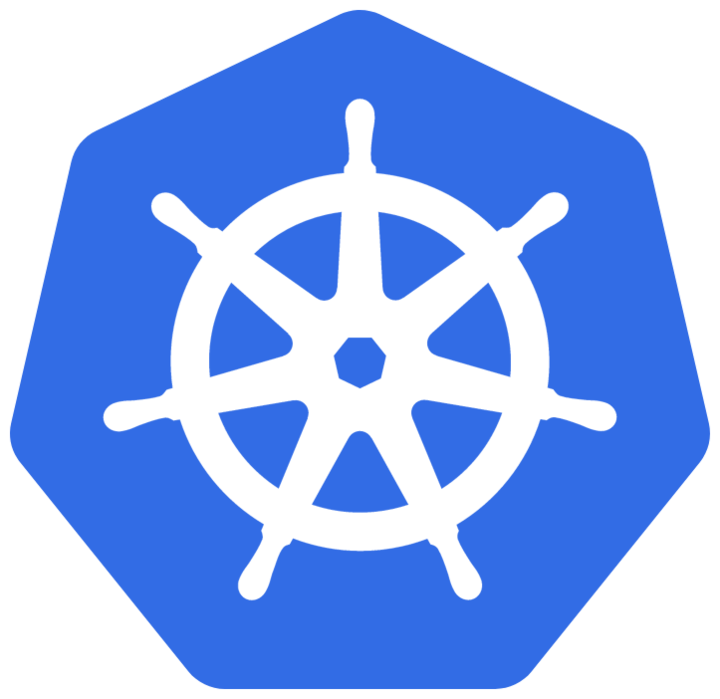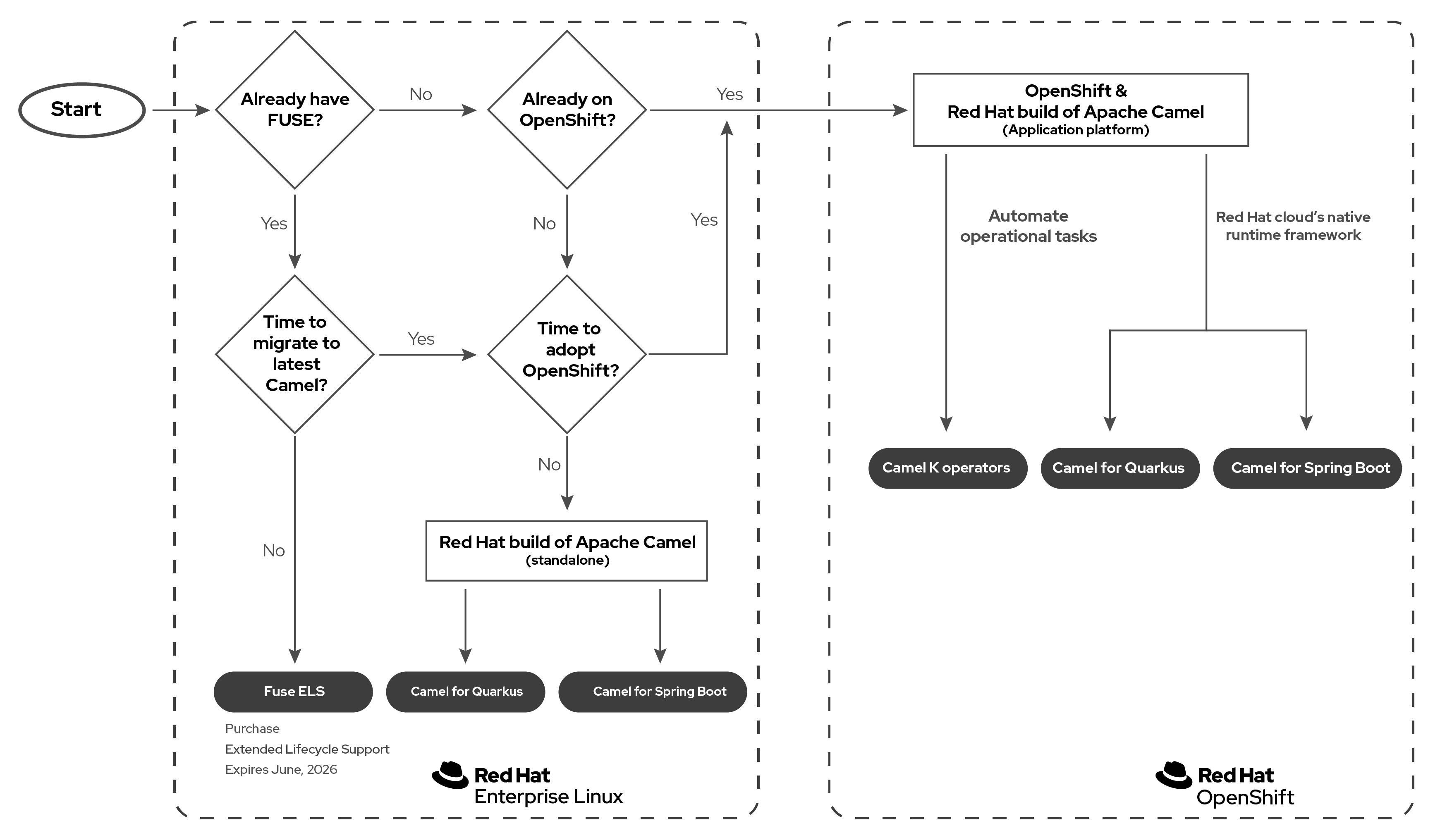Red Hat Fuse
Distributed, cloud-native integration platform
Warning alert
Red Hat Fuse 7.x will go End-of-life (EOL) on June 30, 2024. We recommend users migrate to the Red Hat build of Apache Camel.
For an additional cost, Fuse users may purchase Extended lifecycle support. Learn more about the Red Hat build of Apache Camel on developers.redhat.com.
Red Hat Fuse 7 will move out of the Maintenance Support phase on June 30, 2024. Customers that are running applications on Fuse 7 are recommended to migrate to the Red Hat build of Apache Camel, which is part of Red Hat Application Foundations. This migration involves moving from a traditional Apache Karaf (OSGi) or JBoss EAP centralized server architecture to a Quarkus or Spring Boot microservices architecture. These microservices architectures are a great fit for the emergence of container environments which have revolutionized how applications are built, deployed, and managed.
Red Hat’s Kubernetes-based platform, Red Hat OpenShift, is the platform of choice when planning for many integrations with new microservice and distributed architectures running on containers. In the process outlined below, you can plan a migration to the Red Hat build of Apache Camel.

Apache Camel is the most popular open source integration framework today. The Red Hat build of Apache Camel targets modern cloud native and microservices-based application runtimes such as Spring Boot and Quarkus, which are perfect for developers planning a large number of services on Kubernetes. Camel-based integrations on all-in-one application server architectures like OSGi (Karaf) or Java Enterprise Edition (JBoss EAP) are no longer supported. To assist you in your choice of runtimes as well as running your integration on Openshift, we suggest a 3-series article Choose the best Camel for your integration ride
Camel and Spring Boot form a very popular combo for developers planning for a large number of services deployed on Kubernetes. The movement to microservices and distributed architectures has influenced integration teams to increasingly adopt smaller and more developer-friendly runtimes.
Quarkus is a Java framework tailored for deployment on Kubernetes. Camel on Quarkus is the latest Camel runtime generation. It allows you to run integration processes with super low memory usage, fast startup, and outstanding performance. Quarkus plays a crucial role in ensuring Java's continued relevance and saves organizations from investing effort to seek alternatives to Java. Quarkus also protects an organization’s investment in their Java codebase and preserves continuity.

Camel K is a lightweight integration tool, built to open Apache Camel to a broader audience and lower the barrier to run services in Kubernetes. Camel K provides you with effective integration patterns to manage the inherent complexities of distributed applications. Camel K is based on Kubernetes Operators, and all you need to run an integration is to define its Camel route – that’s it. Once Camel K finds your routing definition, Camel K builds the integration, creates an image, and deploys the image for you. The Operator takes care of the management of Kubernetes-native applications and solves dependency conflicts.
Camel K also introduces predefined Camel routes, called Kamelets. You can pick and choose Kamelets from an out-of-the-box catalog; you’ll just need to configure them. Kamelets are encapsulated-code route components that work as connectors in a Camel integration. Kamelets are simply templates that define the source of data to be consumed and the destination of data to be sent – allowing you to assemble data pipelines. You can, for example, easily configure a data flow from a Java Message Service (JMS) broker to a Kafka platform. Camel K will do the rest. The moment you define your Kamelet pipeline, the Operator triggers an automatic build and deployment of the integration process that executes your flow definition.
The diagram below guides you from Red Hat Fuse to the Red Hat build of Apache Camel. For Red Hat Fuse users choosing to migrate, there are two distinct paths. The first path is to migrate to the Red Hat build of Apache Camel (Camel 4 in this case), but not adopt Red Hat OpenShift. This path supports a standalone mode on VMs or bare metal using Camel for Quarkus and Camel for Spring Boot runtimes. The second path is to migrate to the Red Hat build of Apache Camel along with the adoption of Red Hat Openshift. This path supports a container-based application platform using Camel for Quarkus and Camel for Spring Boot runtimes. The Camel K Operator automates operational tasks on this platform. Users may also choose to stay on Red Hat Fuse by purchasing Extended Lifecycle Support that expires in June, 2026.

Choosing a DSL: Every developer will have to choose a Domain Specific Language (DSL) in connecting subsystems, storage, message brokers, and more. Which Camel DSL should you choose? can help you make your DSL migration choice.
Solution Pattern: Red Hat also offers a solution pattern for the migration from Red Hat Fuse to the Red Hat build of Apache Camel. This pattern offers an accelerated migration path via pre-configured, ready-to-use migration templates tailored for the Quarkus and Spring Boot runtimes with Apache Camel. They allow customers to easily migrate their Camel integration logic to these new runtimes. Learn more from this blog on how this template-based solution pattern can vastly improve your migration efficiency, both in time and effort.
Migration Instructions: As you develop a clear picture on migration runtimes and your choice of a DSL, it will further help to consult the respective migration guides for Red Hat build of Apache Camel for Quarkus and Red Hat build of Apache Camel for Spring Boot. They both cover in detail the required changes when migrating from Fuse 7. It will be necessary to study the changes in Camel 3 and Camel 4 when migrating from Camel 2.23 as used in Fuse 7. Please also study the list of deprecated or removed components in Camel 3 and 4 and their recommended alternatives.
Tooling: Red Hat offers additional tooling in the Red Hat build of Apache Camel. Our Tooling Guide discusses various Visual Studio Code extensions to improve developer productivity and Camel JBang, a CLI tool for rapid Camel development. Red Hat recently added support for a low code / no code Camel editor named Kaoto.
Fuse customers, who are familiar with the Hawtio based Fuse console (either embedded in the JVM running the Camel integrations or running centralized on OpenShift), will be happy to read that Red Hat build of Apache Camel offers a new re-designed Hawtio diagnostic console for managing and monitoring Camel applications on premise and on OpenShift. It works much like the Fuse console and users should quickly become familiar with the new console as well.
Red Hat build of Apache Camel Learning Resources: Use cases and hands-on trials in the Developer Sandbox are outlined with supporting documentation and blogs in the Red Hat build of Apache Camel product pages on developers.redhat.com.
Red Hat Professional Services Help: For users who need assistance with the Fuse to Red Hat build of Apache Camel migration, Red Hat offers professional services that can help you every step of the way. Please contact your Red Hat Sales representative in order to discuss the Fuse-to-Camel offering.